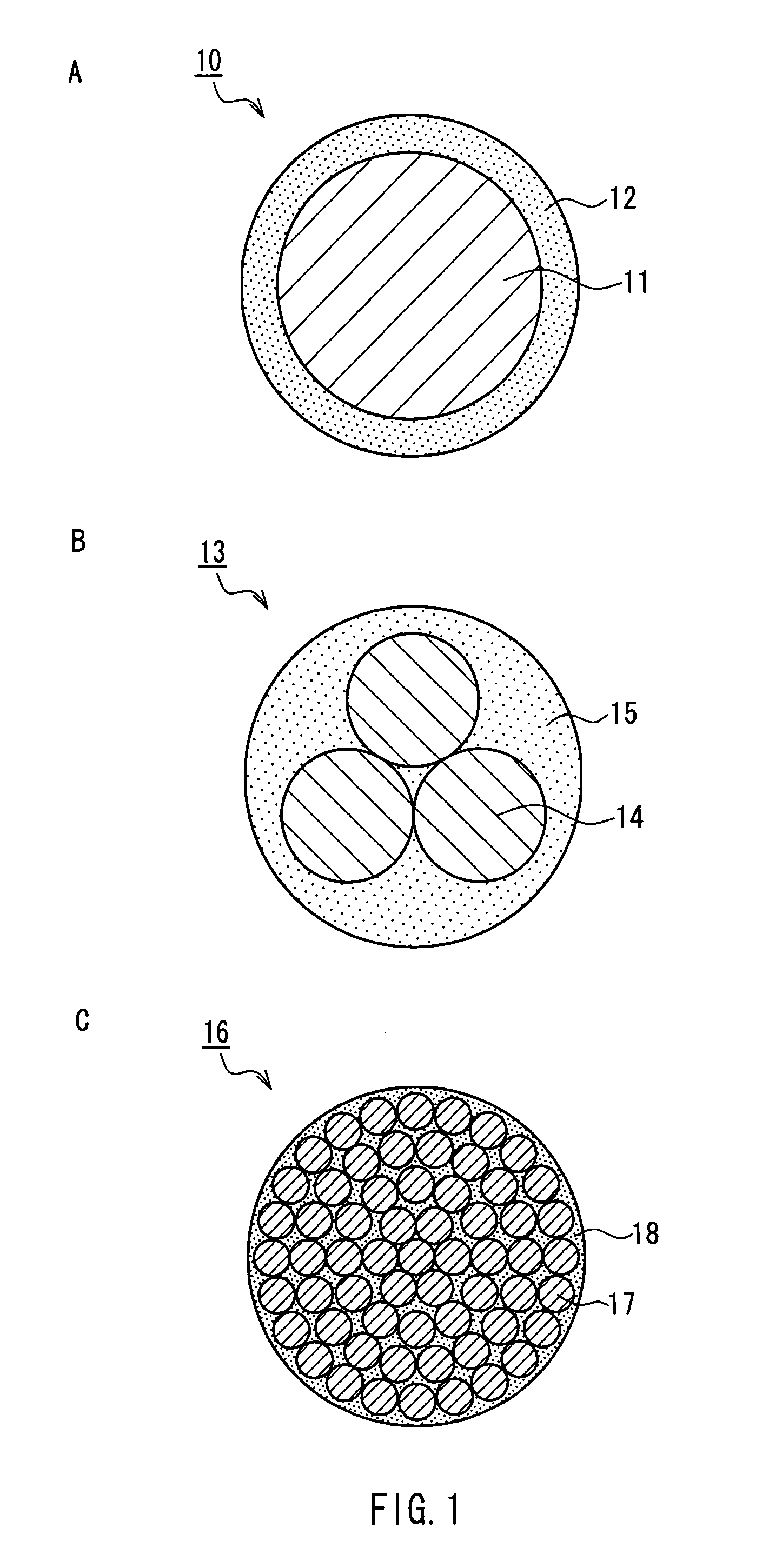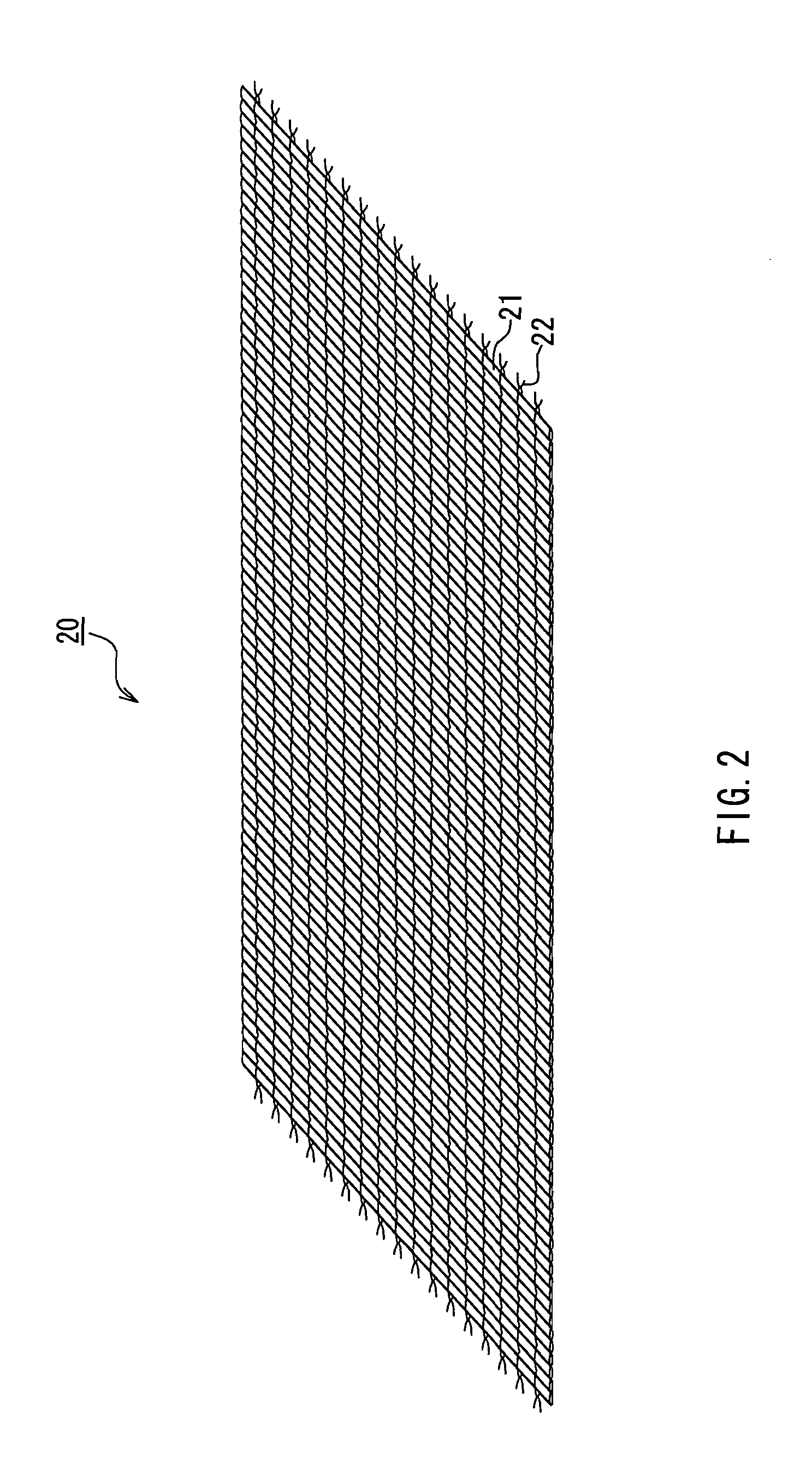Sheet for fiber-reinforced resin and fiber-reinforced resin molded article using the same
a technology of fiber reinforced resin and molded articles, which is applied in the direction of knitting, weaving, straight-bar knitting machines, etc., can solve the problems of carbon fibers, insufficient strength of plastics alone, shortening the life of incinerators, etc., and achieves good adhesion, excellent physical properties, and a higher proportion of reinforcing fibers
- Summary
- Abstract
- Description
- Claims
- Application Information
AI Technical Summary
Benefits of technology
Problems solved by technology
Method used
Image
Examples
example 1
Conventional Example 1
[0054]values in the document about SMC (sheet molding compound press molding method) (“FRP easy enough for anyone to use—introduction to FRP—” edited by Hideaki KASANO, The Japan Reinforced Plastics Society, Sep. 12, 2002, page 68, data in Table 3.30)
Conventional Example 2
[0055]values in the catalog of GMT (sheet composite material made of continuous glass fiber-reinforced thermoplastic resin (polypropylene)) (data on general purpose product “UNISHEET P-grade” (product name) P4038-BK31 available on the website of Quadrant Plastic Composite Japan Ltd.)
TABLE 1ConventionalConventionalExample 1Example 1 (SMC)Example 2 (GMT)Vf (%) of651325reinforcing fiberWf (%) of653040reinforcing fiberTensile elastic8.211.0—modulus (GPa)Tensile strength2159080(MPa)Bending elastic7.610.55.3modulus (GPa)Bending strength97180160(MPa)
[0056]As is evident from Table 1, in Example 1, a higher proportion of the reinforcing fiber was included, so that a higher tensile strength was obtained...
example 2
[0057]An experiment was performed on stitching yarns. The 2 reed screen-like sheets manufactured in Example 1 were laminated at an angle of 90° to form a biaxial substrate. A laminate of the 2 biaxial substrates stacked to form symmetrical angles was used to form a tensile test specimen. A laminate of the 4 biaxial substrates stacked to form symmetrical angles was used to form a bending test specimen. The following stitching yarns were used: a PP filament yarn (fineness: 380 dtex, number of filaments: 60) in Experiment No. 1, a conjugate fiber yarn composed of PP as a core component and PE as a sheath component (mass ratio: PP / PE=50 / 50, fineness: 380 dtex, number of filaments: 60) in Experiment No. 2, and a polyesterbased filament yarn (“Tetoron” (product name) manufactured by Teijin, Ltd., fineness: 80 dtex) in Experiment No. 3. The yarns in Experiments No. 1 and No. 2 had a fineness higher than that in Experiment No. 3 because it was impossible to set a yarn having a lower finenes...
example 3
[0060]An experiment was performed on molding pressures. The 2 reed screen-like sheets manufactured in Example 1 were laminated at an angle of 90° to form a biaxial substrate. A laminate of the 2 biaxial substrates stacked to form symmetrical angles was used to form a tensile test specimen. A laminate of the 4 biaxial substrates stacked to form symmetrical angles was used to form a bending test specimen. The same stitching yarn as in Example 1 was used. Compression molding was performed under the following conditions: the temperature was 130° C., the molding pressures were 1 to 8 MPa, and the molding time was 5 minutes.
[0061]Table 3 shows the above-described results.
TABLE 3Molding pressure1 MPa2 MPa4 MPa8 MPaTensile elastic5.75.85.54.8modulus (GPa)Tensile strength149147150132(MPa)Bending elastic3.13.23.42.5modulus (GPa)Bending strength42.147.649.247.7(MPa)
[0062]As can be seen from Table 3, the molding pressure was preferably 1 to 8 MPa and more preferably about 2 to 4 MPa. It should ...
PUM
| Property | Measurement | Unit |
|---|---|---|
| melting point | aaaaa | aaaaa |
| melting point | aaaaa | aaaaa |
| specific gravity | aaaaa | aaaaa |
Abstract
Description
Claims
Application Information
 Login to View More
Login to View More - R&D
- Intellectual Property
- Life Sciences
- Materials
- Tech Scout
- Unparalleled Data Quality
- Higher Quality Content
- 60% Fewer Hallucinations
Browse by: Latest US Patents, China's latest patents, Technical Efficacy Thesaurus, Application Domain, Technology Topic, Popular Technical Reports.
© 2025 PatSnap. All rights reserved.Legal|Privacy policy|Modern Slavery Act Transparency Statement|Sitemap|About US| Contact US: help@patsnap.com



